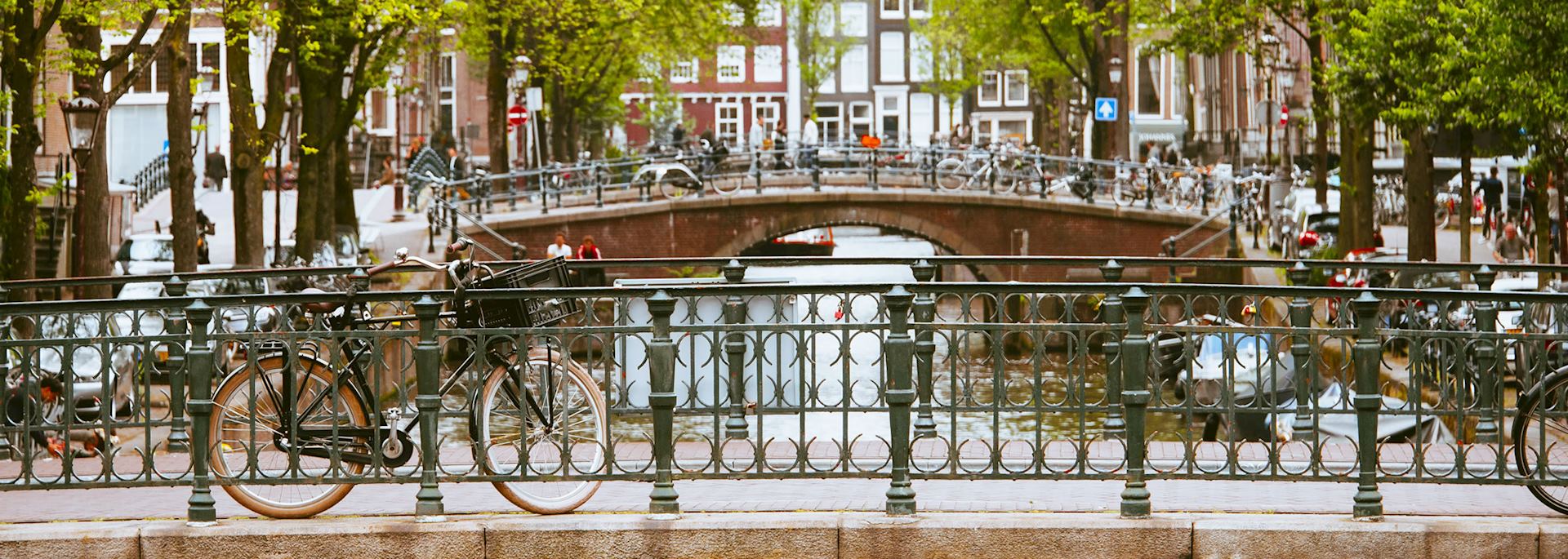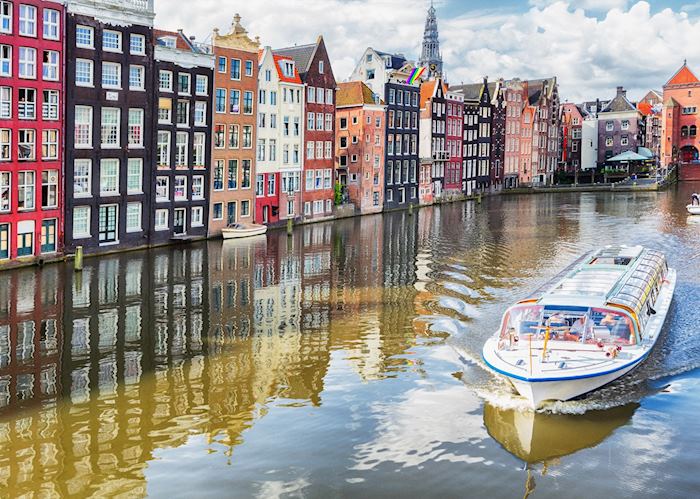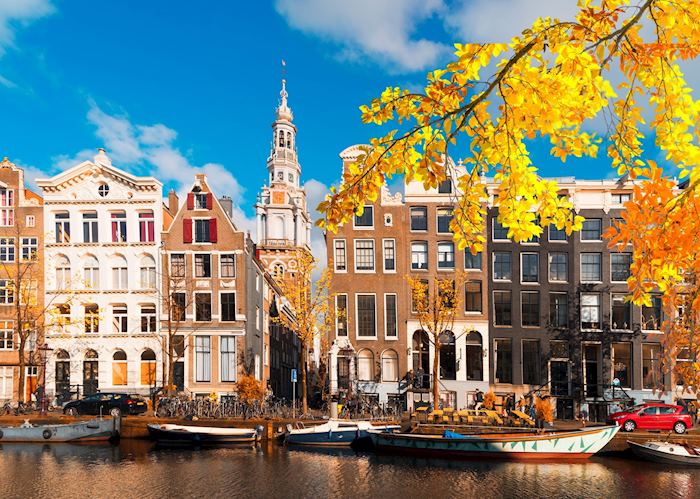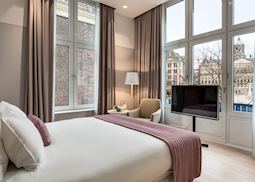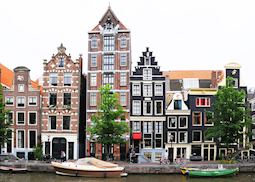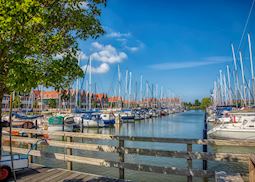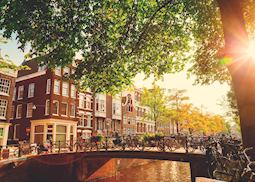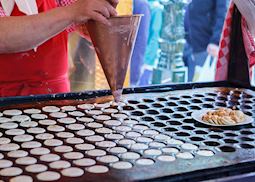Jump to:
A wealth of canals, museums and historical sites marks the romantic city of Amsterdam.
The Netherlands’ capital and a cosmopolitan hub, Amsterdam’s past as a major trading post and colonial power has resulted in a diverse and multifaceted city. You’ll find a free-spirited atmosphere, a plenitude of museums and an unusual building style born of its low-lying, canal-threaded landscape.
 You can take tours exploring Amsterdam’s historic districts or its Jewish history and importance in World War II, including the Anne Frank House. A boat tour along the canals lets you see the city from a different perspective, along with the history of the shipping lanes that still influence the city’s success. See Dutch Masters at the Rijksmuseum, or visit smaller galleries devoted to individual artists, like the Van Gogh Museum and Rembrandt House.
You can take tours exploring Amsterdam’s historic districts or its Jewish history and importance in World War II, including the Anne Frank House. A boat tour along the canals lets you see the city from a different perspective, along with the history of the shipping lanes that still influence the city’s success. See Dutch Masters at the Rijksmuseum, or visit smaller galleries devoted to individual artists, like the Van Gogh Museum and Rembrandt House.
From Amsterdam, it’s easy to visit smaller cities like Edam, Volendam and Alkmaar, visit the beach at Texel or take an hour’s train ride to Utrecht, Rotterdam or The Hague.
Things to see and do in Amsterdam
Dam Square
This cobblestoned open space in the historical heart of Amsterdam is the site of the National Monument, the Royal Palace, the Gothic Nieuwe Kerk or New Church, and a number of shopping and cultural attractions including the De Bijenkorf department store.
The opulent Royal Palace is historically interesting. Originally built in the 17th century at the height of power for the Dutch East Indies Company, the palace wasn’t a royal residence but a town hall fashioned after Roman administrative palaces.
However, the lack of a monarchy didn’t stop the builders from celebrating the wealth, power and global reach of the Netherlands. The central hall is a soaring room of marble, with a map of the then-known world on the floor and a massive statue of Atlas holding up the globe on one end. Deeper inside the palace, an impressive collection of Empire-era furnishings is preserved, from the brief period when Louis Napoleon made the palace his personal residence.
Rijksmuseum
 The immensity of the Rijksmuseum, the Dutch national museum of arts and history, advertises itself well before you enter it. Opened in its current form in 1885, the Gothic- and Renaissance-inspired brick and stone structure, with its massive arched windows and detailed friezes, looks like a cathedral to art.
The immensity of the Rijksmuseum, the Dutch national museum of arts and history, advertises itself well before you enter it. Opened in its current form in 1885, the Gothic- and Renaissance-inspired brick and stone structure, with its massive arched windows and detailed friezes, looks like a cathedral to art.
Located in the museum square near the Van Gogh museum and the Vondelpark, the building houses many paintings by Vermeer, Rembrandt (including the colossal Night Watch), Frans Hals and other Dutch Masters. There are around 2,000 paintings in total, amid a collection of one million objects of art, craft and history.
Anne Frank House
Located in the house where Anne Frank and her family hid, the Anne Frank House is one of the Netherlands’ most visited sites. We can arrange a walking tour themed around the life of Anne Frank. If you wish to visit the museum itself, we recommend booking in advance, as tickets sell out quickly.
Within the 17th-century canal house, several rooms have been preserved in their original state, including the bookcase that hid the staircase to the family’s shelter, letters and photos, a tea set and markings on the wall showing the children’s growth.
The museum also houses a permanent exhibition on the life and times of Anne Frank, and another exhibit examining all forms of persecution and discrimination. Because of the narrow staircases, the museum may be difficult to visit for those with limited mobility.
Jordaan district
Originally built for the working class and immigrant populations in the early 17th century, the Jordaan district has long been known for its quirky little houses, narrow and numerous canals and close-knit communities. Preservation efforts in the 1970s headed off the area’s demolition for modern development, and now the Jordaan is a fashionable place where you can visit markets, cafés, bars and the tiny bridges spanning the canals.
We can arrange a walking or cycling tour through the district, including the UNESCO-protected Nine Streets, which feature boutique shops, cafés and restaurants inside many-hued canal house buildings. The Jordaan is also the location of the Anne Frank House, as well as the Canal House Museum and other cultural landmarks.
The Venice of the North
 Amsterdam is a city of canals, its central ring a series of concentric waterways that have led some to call it the Venice of the North. The three main canals, dug during the 17th century in the Dutch Golden Age, are criss-crossed with smaller canals throughout the Grachtengordel, the city’s watery heart.
Amsterdam is a city of canals, its central ring a series of concentric waterways that have led some to call it the Venice of the North. The three main canals, dug during the 17th century in the Dutch Golden Age, are criss-crossed with smaller canals throughout the Grachtengordel, the city’s watery heart.
The well-preserved canal houses, pleasure boats, narrow streets and arched-brick bridges give the city a rich texture, and the golden glow of the streetlights in the evening make it especially romantic to walk after dark. We can arrange a canal boat tour for you to see the city from this perspective and learn more about the history of its busy waterways.
Canal House Museum (Het Grachtenhuis)
With life alongside canals came canal houses — tall, narrow structures with entrances usually up a set of stairs in case of flooding. Het Grachtenhuis, or the Canal House Museum, is a particularly grand home built in 1667 for a wealthy merchant, wider than most of its fellows and with a frieze decorating its brick-and-ivory façade.
Inside the building, some of the original decor has been preserved, including the floors and some of the wall paintings. There is also a complete model of the house in miniature, echoing another strong Dutch tradition of detailed dollhouses. Much of the exhibit, however, details how Amsterdam developed from its early days as a fishing village to become the trading juggernaut of the Dutch Golden Age, using city council plans, model representations and other physical manifestations of the city’s history.
Rembrandt House Museum
Most of Rembrandt’s most renowned paintings are in the Rijksmuseum, but you can visit the house where he lived from 1639 and 1656 and created many of his best-known works. The narrow townhouse, with its green arched door and bold window shutters — green on the outside, red on the inside — holds a reconstructed interior reflecting its condition during Rembrandt’s residence there.
In addition to clues to his everyday life, the museum also has a collection of paintings, as well as etchings and drawings that would later become his better-known works.
De Wallen
Popularly known as Amsterdam’s red light district, De Wallen is one of Amsterdam’s oldest areas, and while it’s best known for the sex workers who pose in windows to draw business, it also contains Amsterdam’s oldest church, juxtaposed with museums that document its rich history.
You can walk the cobblestoned residential streets, where many locals still live, including the shoulder-width Trompettersteeg, one of the narrowest streets in the world. There are also plenty of cafés to visit, where coffee and soft drinks are served alongside a menu of cannabis products.
The Oude Kerk or Old Church sits at the middle of De Wallen, which is itself Amsterdam’s medieval heart. Originally built as a wooden chapel in 1213, the newer stone structure was consecrated in 1306.
Hofjes
Tucked into otherwise busy parts of the city, you’ll find secluded courtyards, called hofjes, which are bounded by houses originally built to protect people in need. The most notable is the Begijnhof, a hofje that was originally an example of the Catholic cloisters for Beguines — women who dedicated themselves to a monastic lifestyle without taking religious vows. Today, the tall townhouses around the peaceful, grassy courtyard are mostly private dwellings, and include one of the only two wooden houses remaining in the town’s heart, dating from 1528.
Other hofjes are scattered throughout the city, with almshouses around their courtyards that have housed mostly women in need since medieval times. Some are still active, and many are open to the public.
Food tour
 While the Dutch aren’t widely known for their cuisine, a wide selection of comforting dishes are on display in Amsterdam. Hearty stews, fresh fish from the North Sea, puffy pancakes and caramel-sweet stroopwafels are great fuel for all the walking and cycling that Amsterdam encourages.
While the Dutch aren’t widely known for their cuisine, a wide selection of comforting dishes are on display in Amsterdam. Hearty stews, fresh fish from the North Sea, puffy pancakes and caramel-sweet stroopwafels are great fuel for all the walking and cycling that Amsterdam encourages.
We can arrange a food walking tour where you can taste some of the Netherlands’ staple dishes. You can try bitterballen, a ragout-like stew that’s rolled into a ball, breaded and fried. Fried fish is also popular, though if you’re adventurous you might try Hollandse nieuwe, a brined raw herring usually served with chopped onion and gherkin, or smoked eel.
Local Dutch beer is a treat, heavily influenced by Belgian traditions. And don’t forget the cheeses, like Edam and Gouda, that are so plentiful in the local markets. For dessert, stroopwafels can be found on many street corners, and poffertjes — small pancakes served with a chunk of butter and icing sugar — are also common.
Outside the city
We can also arrange day trips from Amsterdam to see some of the more rural parts of the country. The Keukenhof tulip fields, where you can see an incredible variety of tulip shades and shapes, bloom from March to May.
Zaanse Schans, a historical district dedicated to preserving old windmills and wooden houses, is open year-round. The windmills, a familiar national symbol, are all historic working mills from the 16th century onward, which have been moved to this spot as a means of protecting Dutch heritage.
You can also travel to Texel, a popular beach area, as well as historic towns like Alkmaar, Volendam and Edam.
Best time to visit Amsterdam
The weather in the Netherlands is mild all year, however it’s known for regular rainfall. The months of March through May see flowers in bloom on the trees surrounding the canals, and restaurants and cafés start seating on the streets and terraces, so the city comes alive. The flower market is in full swing too, with the windmills and tulip fields nearby for an easy day trip.
The summer months of June through August can be extremely busy, so we recommend March through May or September through November as the best seasons to visit, along with the Christmas season for the markets.
who's been there
Start planning your tailor-made trip to Amsterdam by contacting one of our Netherlands specialists
-
01993 838 92501993 838 407
- Make an enquiry
Places near Amsterdam
- Utrecht 21 miles away
- The Hague 34 miles away
- Rotterdam 37 miles away
- Maastricht 111 miles away
Photos of Amsterdam
Accommodation choices for Amsterdam
We've selected a range of accommodation options for when you visit Amsterdam. Our choices usually come recommended for their character, facilities and service or location. Our specialists always aim to suggest properties that match your preferences.
-
![Purple double room]()
Ambassade Hotel
Amsterdam -
![Sofitel Legend The Grand, Amsterdam]()
Sofitel Legend The Grand
Amsterdam -
![XL room with a view]()
-
![De L'Europe, Amsterdam]()
De L'Europe
Amsterdam -
![Maison Elle exterior]()
Maison Elle
Amsterdam
Ideas for experiencing Amsterdam
Our specialists seek out authentic ways to get to know the places that could feature in your trip. These activities reflect some of the experiences they've most enjoyed while visiting Amsterdam, and which use the best local guides.
-
Anne Frank walking tour ![Anne Frank tour, Amsterdam]()
Anne Frank walking tour
Anne Frank walking tour
Learn about the rich and lengthy history of Jewish culture in Amsterdam on this guided walking tour of Amsterdam’s Jewish Quarter. Then, see the former home and school of Anne Frank, and memorial plaques dedicated to her and her family.
View details -
Edam, Marken & Volendam ![Marina of Volendam]()
Edam, Marken & Volendam
Edam, Marken & Volendam
Head out of the city with your local guide and see the traditional towns of Edam, Marken and Volendam. See how they built houses on low land in the 17th century, sample Edam cheese and try local fish delicacies on this day-long tour.
View details -
Jordaan District & Houseboat Museum by bike ![Sunset in the Jordaan district]()
Jordaan District & Houseboat Museum by bike
Jordaan District & Houseboat Museum by bike
Bike through the Jordaan District and admire the brick house-lined streets, high-end boutiques and terrace cafés in this stylish area of Amsterdam on this guided tour. Then, explore the Houseboat Museum and see what life on the city’s canals looks like.
View details -
Dutch food tour ![Dutch pancakes, Amsterdam]()
Dutch food tour
Dutch food tour
Spend a morning or afternoon wandering the chic Jordaan district of Amsterdam with your local guide, who will show you the best places to enjoy Dutch delicacies. Fuel your four-hour walk with bitterballen, poffertjes, smoked fish and rich cheeses.
View details


